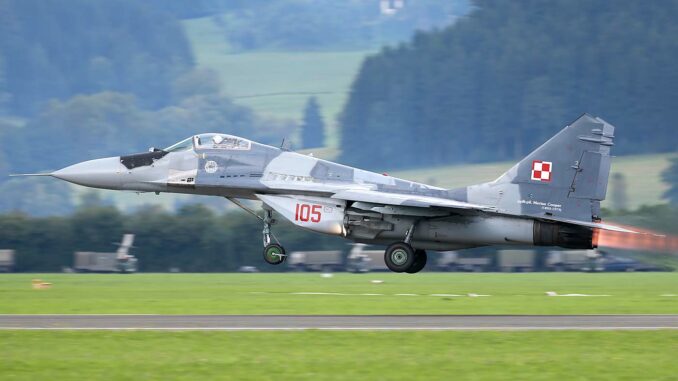
In this article, we compare the Dassault Rafale and MiG-29 in detail, highlighting their performance, technology and cost, to reveal the superior choice.
The aircraft: Dassault Rafale vs Mikoyan-Gurevich MiG-29
Dassault Rafale
The Dassault Rafale, a jewel in the crown of French military aviation, is renowned for its versatility, its ability to carry out a wide range of aerial missions, from reconnaissance to direct attack. Designed in the 1980s and entering service in the late 1990s, the Rafale benefits from advanced technology that gives it excellent maneuverability and unrivalled multi-role capability. It is powered by two Snecma M88 engines, which deliver substantial thrust, enabling a maximum speed in excess of Mach 1.8 (over 1,800 km/h). Its optimized aerodynamic design, combined with the use of composite materials, gives it lightness and solidity, improving its flight performance and durability. The Rafale is also equipped with sophisticated electronic systems for combat, navigation and communication, and an active antenna radar that enhances its target detection and tracking capability. Despite its advances, its high acquisition and maintenance costs represent a challenge.
MiG-29
The MiG-29, designed by the Mikoyan design bureau in the Soviet Union, was introduced in the 1980s to counter American fighters. It excels in the role of air superiority thanks to its exceptional maneuverability and top speed of Mach 2.25 (approx. 2,400 km/h). The MiG-29 is powered by two RD-33 turbofan engines, offering impressive flight performance and the ability to operate at high altitudes. However, it is often criticized for its relatively limited range and autonomy, which restrict its use to long-distance missions without refueling. Although equipped with powerful armament and advanced sighting systems for the era of its design, the MiG-29 is perceived as having less sophisticated electronics and battlefield survival capabilities by today’s standards, especially when compared with fifth-generation aircraft or recent modernizations of aircraft in its class.
Now, let’s analyze each criterion given to evaluate these two aircraft.
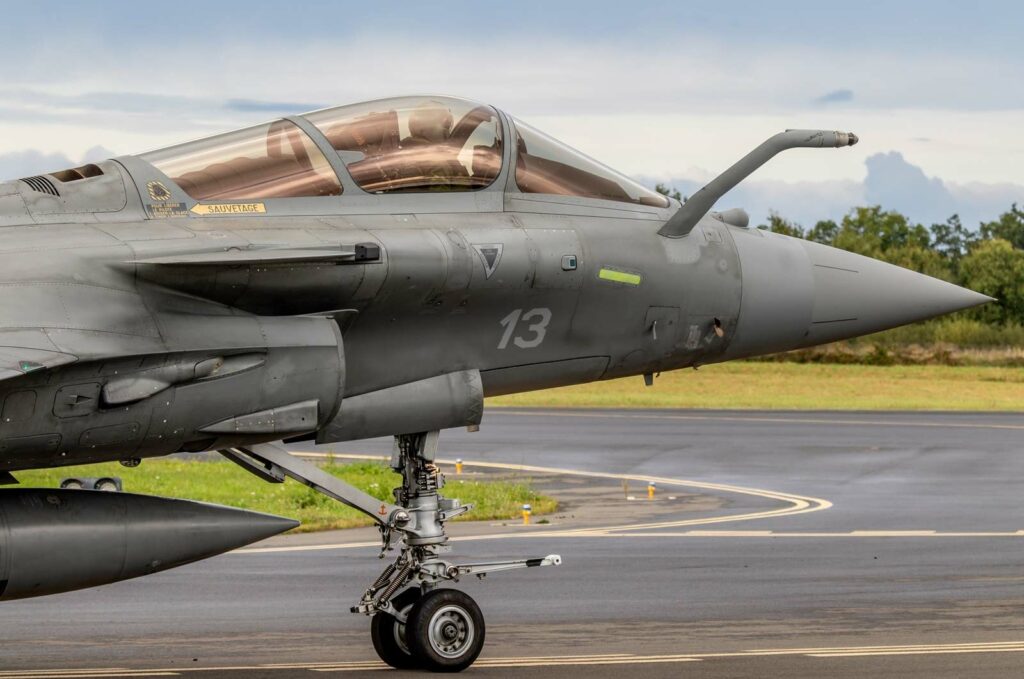
Technical criteria
Maximum take-off weight
Definition: Maximum take-off weight is the total weight an aircraft can carry at take-off, including fuel, crew, weapons and cargo. It is a key indicator of the aircraft’s ability to carry fuel and weapons for its missions.
- Point for Dassault Rafale : The Rafale has a higher maximum take-off weight, enabling it to carry more fuel and weapons, offering greater versatility and endurance on missions.
Range
Definition: The range is the maximum distance an aircraft can cover from its point of departure, without needing to refuel. This is crucial for combat missions, as it determines the aircraft’s operational range.
- Point for Dassault Rafale: With its extended range, the Rafale can carry out long-range missions without refueling, surpassing the MiG-29 in this respect.
Maximum speed
Definition: Maximum speed is the highest speed an aircraft can reach in flight. High speed can be decisive in air-to-air combat and in evading enemy defenses.
- Point for MiG-29: The MiG-29, with its slightly higher maximum speed, has an advantage in situations requiring rapid evasion or interception.
Operational ceiling
Definition: The maximum altitude at which an aircraft can fly efficiently. A high operational ceiling means that most anti-aircraft defenses can be avoided, giving you an advantage in air-to-air combat.
- Point for MiG-29: The MiG-29 has a higher operational ceiling, offering a better ability to operate at altitudes where it is less likely to be detected or reached by enemy defenses.
Maneuverability
The ability of an aircraft to change direction and altitude rapidly. Good maneuverability is essential for close air combat and missile avoidance.
- Point for MiG-29: Renowned for its outstanding maneuverability, the MiG-29 excels in close air combat, outperforming the Rafale in this specific field.
Weapon-carrying capability
Definition: The types and quantities of weapons an aircraft can carry. A high weapons-carrying capacity allows greater flexibility in attack and defense missions.
- Point for Dassault Rafale : With its versatile design, the Rafale can carry a greater variety and quantity of weapons, making it more adaptable to various combat scenarios.
Autonomy
Definition: The maximum time the aircraft can remain in the air without refueling. Long range is essential for extended missions and surveillance.
- Point for Dassault Rafale : The Rafale’s improved energy efficiency and fuel capacity provide superior autonomy, essential for long-duration missions.
Propulsion system
Definition: Engine type and performance determine the aircraft’s speed, altitude and endurance. An advanced propulsion system guarantees superior in-flight performance.
- Point for Dassault Rafale : The Rafale’s M88 engines provide superior thrust and greater efficiency, offering optimum flight performance and reduced maintenance.
Stealth capabilities
Definition: An aircraft’s ability to avoid detection by radar. Stealth capabilities are crucial for infiltration missions and survival in heavily defended environments.
- Point for Dassault Rafale : Although neither the Rafale nor the MiG-29 are designed as pure stealth aircraft, the Rafale incorporates elements that reduce its radar signature, giving it a slight advantage in this area.
Scientific criteria
Materials used
Definition: Innovations in materials for aircraft lightness and strength. The use of advanced materials reduces weight, improves performance and increases durability.
- Point for Dassault Rafale : The Rafale takes advantage of advanced composite materials for much of its structure, offering an optimal combination of lightness and strength.
Aerodynamics
Definition: Effective design to minimize air resistance. Excellent aerodynamics improve speed, fuel economy and maneuverability.
- Point for Dassault Rafale: Its sophisticated aerodynamic design enables the Rafale to offer reduced aerodynamic drag, which translates into better flight efficiency than the MiG-29.
On-board electronic systems
Definition: Technological advances in navigation, communication and combat systems. Advanced electronic systems increase the aircraft’s operational efficiency and survivability.
- Point for Dassault Rafale : The Rafale is equipped with advanced electronic systems, including an active antenna radar and an advanced electronic warfare system, surpassing the initial capabilities of the MiG-29.
Simulation and training capabilities
Simulation technology for pilot training. Advanced simulators enable realistic and safe training, reducing training time and costs.
- Point for Dassault Rafale : The Rafale program includes comprehensive, modern simulation and training systems, providing superior preparation for pilots.
Energy efficiency
Definition: Optimization of fuel consumption. Improved fuel efficiency reduces operating costs and increases aircraft range.
- Point for Dassault Rafale : The Rafale’s M88 engines are designed for optimum fuel efficiency, contributing to greater range and lower operating costs.
Noise reduction technologies
Definition: Innovations to minimize aircraft noise. Reducing noise is essential for operating close to inhabited areas and reducing environmental impact.
- Point for Dassault Rafale: Although noise reduction technologies are not often specifically highlighted in military data sheets, the development and use of advanced technologies in Rafale engines suggests a particular focus on noise reduction.
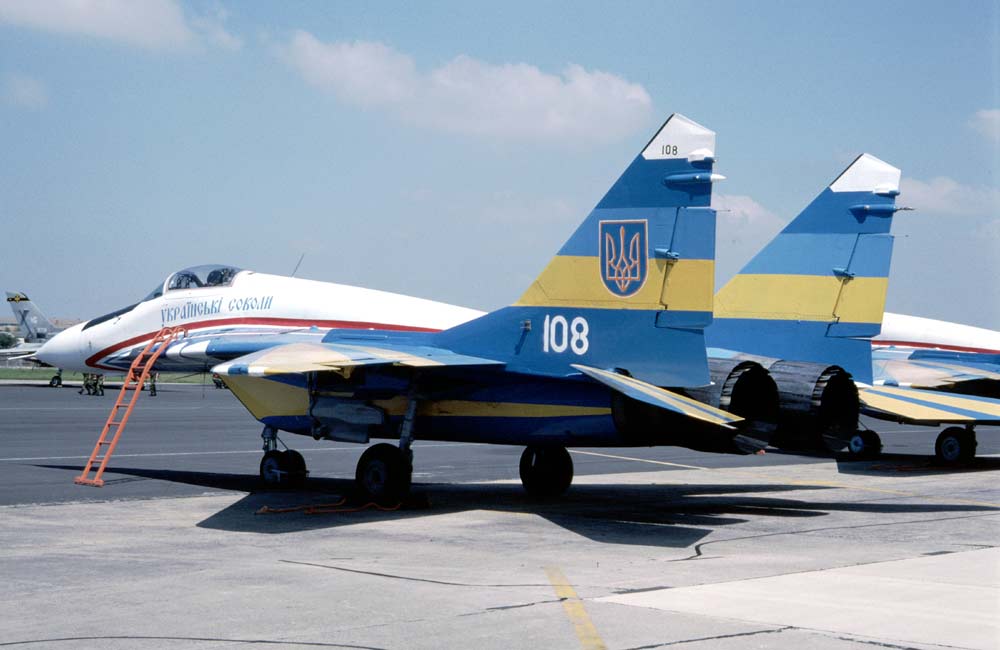
Budgetary criteria
Acquisition cost
Definition: Purchase price of the fighter aircraft. A lower acquisition cost makes the aircraft more affordable for a given defense budget.
- Point for MiG-29: Traditionally, the MiG-29 has a lower acquisition cost than the Rafale, making it a more economical option for countries with limited defense budgets.
Maintenance cost per year
Definition: Annual cost of maintaining the aircraft in working order. A lower maintenance cost means substantial savings over the aircraft’s operational life.
- Point for Dassault Rafale: Despite a higher acquisition cost, the Rafale is designed for simplified and less frequent maintenance, potentially reducing annual costs compared with the MiG-29.
Operational life
Period during which the aircraft can be operated effectively before requiring replacement or a major upgrade. A long operational life reduces the overall cost per year of use.
- Point for Dassault Rafale : The Rafale, with its advanced technologies and modular design for easy upgrades, has a potentially longer operational life than the MiG-29.
Personnel training costs
Definition: Investment needed to train pilots and technical staff. More efficient and less costly training is preferable.
- Point for Dassault Rafale : The Rafale’s comprehensive simulation and training systems enable effective and potentially less costly training over the long term.
Operating costs
Definition: Costs associated with the regular use of the aircraft, including fuel, spare parts, etc. Lower operating costs improve budget efficiency.
- Point for Dassault Rafale : The Rafale’s superior fuel efficiency and less frequent maintenance contribute to lower operating costs than the MiG-29.
Operational criteria
Compatibility with existing infrastructure
Definition: Ability of the aircraft to operate from existing air bases without the need for major modifications. Good compatibility facilitates integration and reduces costs.
- Point for MiG-29 : The MiG-29, due to its long presence on the market and its use by many countries, shows excellent compatibility with a variety of existing infrastructures.
Ease of maintenance
Definition: Level of competence required for technical personnel and availability of spare parts. Easy maintenance reduces downtime and costs.
- Point for Dassault Rafale: Although the MiG-29 is designed to be robust, the Rafale benefits from a modular design and well-established support logistics, making maintenance easy.
Interoperability
Definition: The ability of an aircraft to operate effectively in joint missions with forces or equipment from other countries. Interoperability is crucial for multinational operations.
- Point for Dassault Rafale : The Rafale, with its advanced electronic systems and compatibility with NATO standards, offers greater interoperability for international operations.
Versatility
Definition: The ability of an aircraft to perform a variety of missions. A versatile aircraft can fulfill several roles, reducing the need for specialized aircraft.
- Point for Dassault Rafale: Designed as a multi-role aircraft, the Rafale excels in a variety of missions, from air superiority to ground attack, demonstrating superior versatility to the MiG-29.
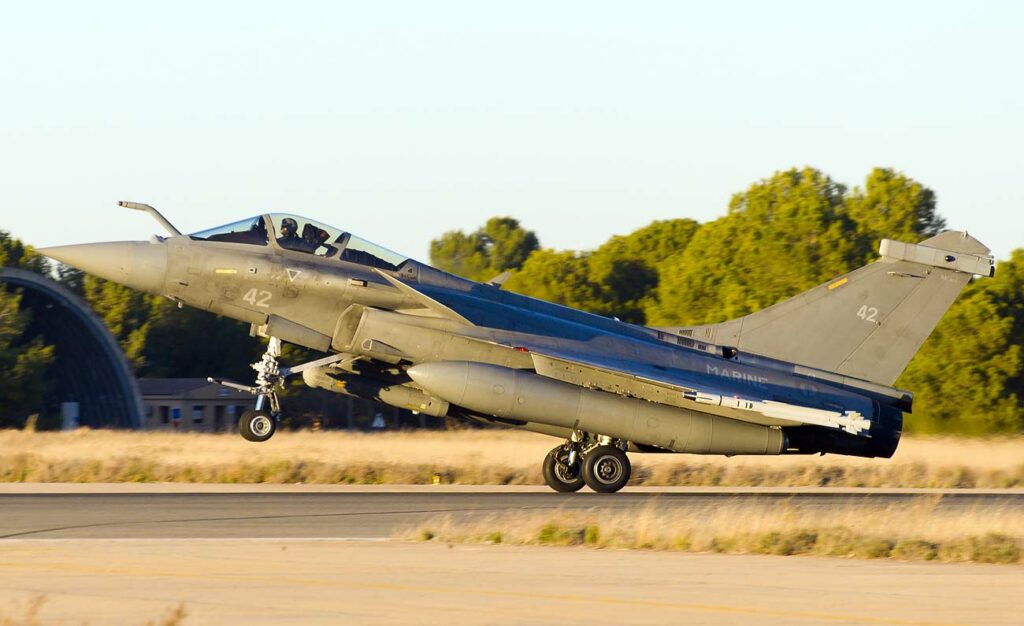
Strategic criteria
Adaptability to technological change
Definition: Ease with which the aircraft can be updated or modified to incorporate new technologies or capabilities. Good adaptability ensures the continued relevance of the aircraft to technological advances.
- Point for Dassault Rafale: Its modular design and the manufacturer’s commitment to continuous development make the Rafale a more adaptable choice for technological evolutions than the MiG-29.
Manufacturer support
Manufacturer’s commitment to providing long-term technical and logistical support. Strong manufacturer support guarantees the availability of parts and the necessary technical assistance.
- Point for Dassault Rafale: Dassault Aviation has demonstrated a strong commitment to supporting the Rafale worldwide, offering a level of support superior to that available for the MiG-29.
Export potential
Acceptability of the aircraft on the international market, which can influence unit costs through economies of scale. High export potential benefits both the manufacturer and users.
- Point for Dassault Rafale : The Rafale has seen an increase in acceptance on the international market, strengthening its export potential and long-term economic benefits.
Environmental criteria
Ecological footprint
Environmental impact of the aircraft, including CO2 emissions and fossil fuel consumption. Minimizing the ecological footprint is crucial in the current context of climate change.
- Point for Dassault Rafale : The Rafale’s superior fuel efficiency helps reduce its ecological footprint compared with the MiG-29.
Noise pollution
Level of noise generated, particularly relevant near inhabited areas. Reducing noise pollution is important to limit the impact on local populations.
- Neutral point : Specific noise pollution data are less frequently published for military aircraft. However, the general commitment to advanced technologies suggests that the Rafale may have a minor advantage in this area.
Safety criteria
Accident rate
Definition: Aircraft safety history, including incidents and accidents. A low accident rate is indicative of safe design and adequate pilot training.
- Neutral point : Both aircraft have accident rates that reflect their operating periods and contexts of use. A direct comparison would require a detailed analysis of the specific circumstances of each incident.
Survivability
Definition: The ability of an aircraft to protect its occupants and remain operational in the event of an attack. High survivability increases the chances of mission success and pilot safety.
- Point for Dassault Rafale : The Rafale is equipped with electronic warfare systems and advanced protection measures, enhancing its ability to survive in hostile environments.
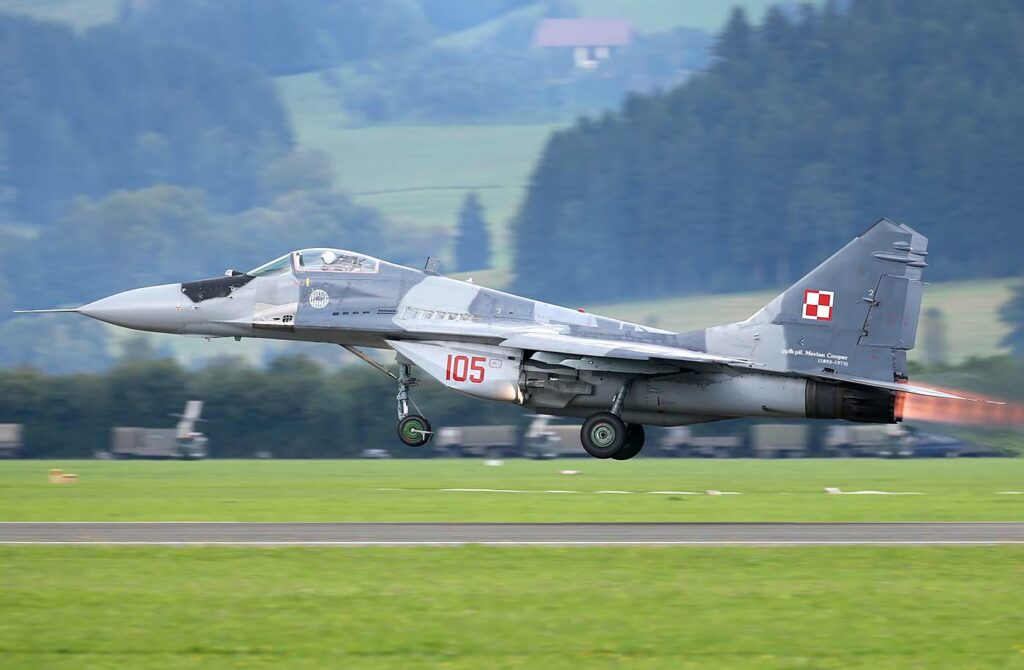
Political and economic criteria
Geopolitical relations
Definition: Relations between producer and buyer countries can influence the purchasing decision. Positive relations can facilitate purchasing agreements and technical support.
- Neutral point: This criterion varies significantly according to the geopolitical context, and cannot be attributed in a general way to one aircraft or another.
Impact on local employment
Definition: Effects of the acquisition on the national defense industry and job creation. A positive impact on local employment is often a factor in purchasing decisions.
- Neutral point : The impact on local employment will depend on specific agreements between the acquiring countries and the manufacturers, making this criterion difficult to assess globally for both aircraft.
Victory for the Rafale
Analyzing technical, scientific, budgetary, operational, strategic, environmental, safety, political and economic criteria, the Dassault Rafale stands out as superior in most categories. Its advanced design, versatility, multi-role capabilities, fuel efficiency and manufacturer support make it a preferable choice in many scenarios. Although the MiG-29 offers certain advantages, such as a slightly higher top speed and lower acquisition cost, the Rafale’s innovations and modularity ensure its overall superiority, both for current missions and for future adaptations. The Dassault Rafale is the best choice for air forces looking for a modern, efficient and versatile fighter capable of meeting the challenges of the 21st century.
War Wings Daily is an independant magazine.